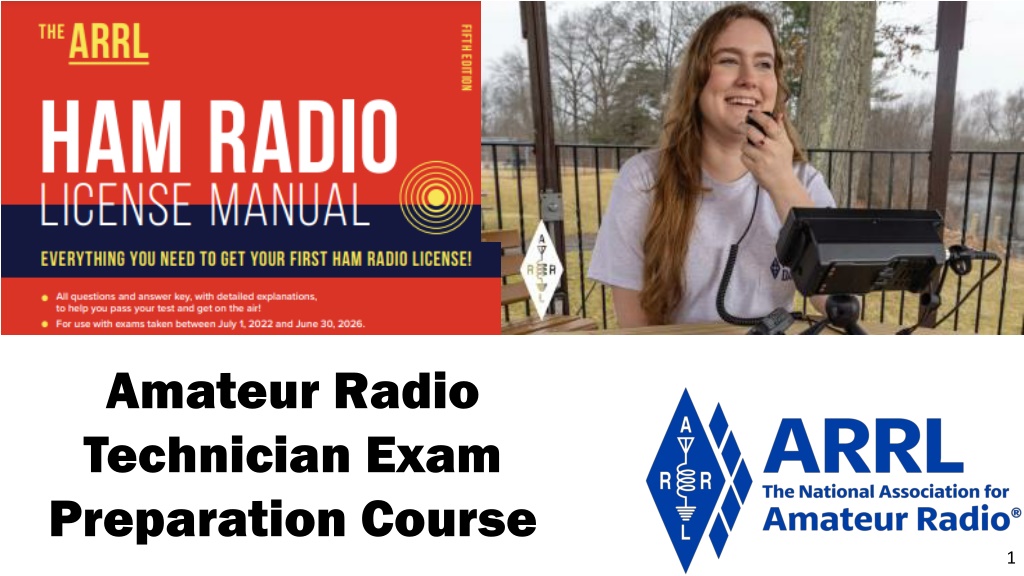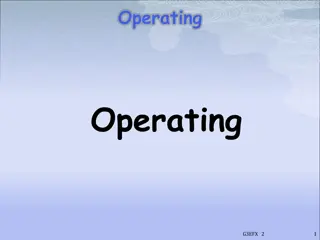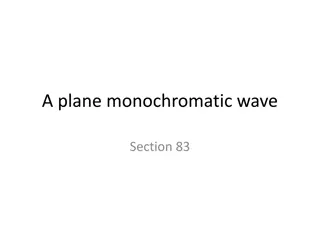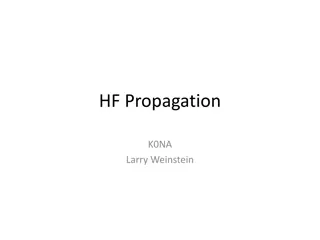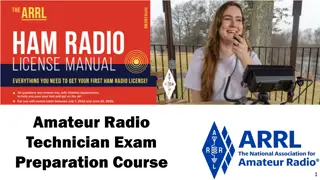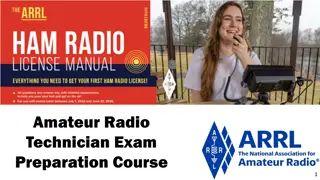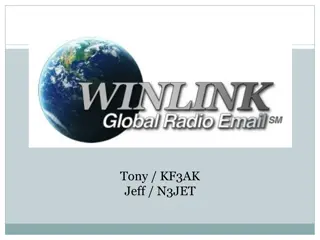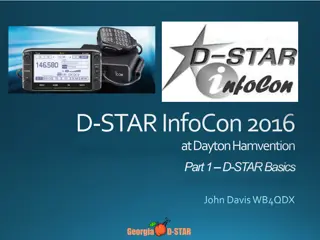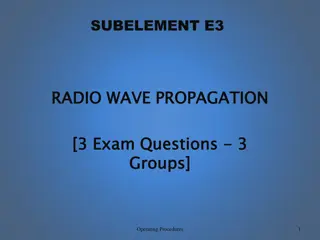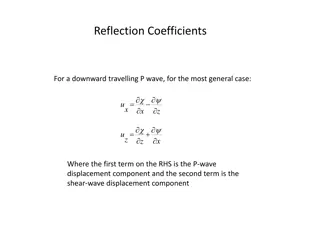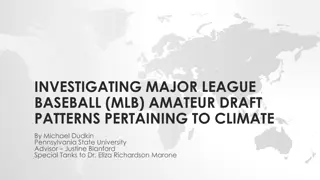Understanding Radio Wave Propagation for Amateur Radio Technicians
Discusses the various ways radio waves propagate based on frequency and environmental characteristics, including line of sight, ground wave, and sky wave. Explains how radio energy travels in a straight line, follows the Earth's surface, reflects, refracts, and diffracts. Covers multipath interference and absorption by different materials in the environment.
Download Presentation

Please find below an Image/Link to download the presentation.
The content on the website is provided AS IS for your information and personal use only. It may not be sold, licensed, or shared on other websites without obtaining consent from the author. Download presentation by click this link. If you encounter any issues during the download, it is possible that the publisher has removed the file from their server.
E N D
Presentation Transcript
Amateur Radio Technician Exam Preparation Course 1
Amateur Radio Technician Exam Prep Course Module 4 Propagation, Antennas, and Feed Lines 4.1 Propagation 4.2 Antenna and Radio Wave Basics 4.3 Feed Lines and SWR 4.4 Practical Antenna Systems 2 2
Propagation Radio waves propagate in many ways depending on Frequency of the wave Characteristics of the environment We will discuss three basic ways: Line of sight Ground wave Sky wave 3 3
Line of Sight Radio energy can travel in a straight line from a transmitting antenna to a receiving antenna called the direct path There is some attenuation of the signal as the radio wave travels due to spreading out This is the primary propagation mode for VHF and UHF signals Radio waves can be reflected by any sudden change in the path they are traveling, such as a building, hill, or even weather-related changes in the atmosphere Vegetation can also absorb VHF and UHF radio waves Precipitation such as fog and rain can absorb microwave and UHF radio waves although it has little effect at HF and on the lower VHF Bands 4 4
Ground Wave At lower HF frequencies radio waves can follow the Earth s surface These waves will travel beyond the range of line-of-sight Range of a few hundred miles 5 5
Reflect, Refract, Diffract Radio waves are reflected by any conductive surface Ground, water, buildings Refraction or bending occurs when waves encounter a medium having a different speed of light, such as water or an electrical feed line By bending signals slightly back towards the ground, refraction counteracts the curvature of the Earth and allows signals to be received at distances beyond the visual horizon Knife edge diffraction: Diffraction as waves travel past sharp edges of large objects 6 6
Multipath Radio signals arriving at a receiver after taking different paths from the transmitter Results in irregular fading, even when reception is generally good Because dead spots from multipath are usually spaced about - wavelength apart, VHF or UHF signals from a station in motion can take on a rapid variation in strength known as mobile flutter or picket- fencing Distortion caused by multipath can also cause VHF and UHF digital data signals to be received with a higher error rate, even though the signal may be strong 7 7
Tropospheric Propagation Propagation at and above VHF frequencies are assisted by variations in the atmosphere Variations such as weather fronts or temperature inversions create layers of air next to each other that have different characteristics The layers form structures called ducts that can guide even microwave signals for long distances Regularly used by amateurs to make VHF and UHF contacts that would otherwise be impossible by line-of-sight propagation (300 miles or more) 8 8
Why do VHF signal strengths sometimes vary greatly when the antenna is moved only a few feet? A. The signal path encounters different concentrations of water vapor B. VHF ionospheric propagation is very sensitive to path length C. Multipath propagation cancels or reinforces signals D. All these choices are correct T3A01 C 4-1 10 10
What is the effect of vegetation on UHF and microwave signals? A. Knife-edge diffraction B. Absorption C. Amplification D. Polarization rotation T3A02 B 4-1 11 11
What is the meaning of the term picket fencing? A. Alternating transmissions during a net operation B. Rapid flutter on mobile signals due to multipath propagation C. A type of ground system used with vertical antennas D. Local vs long-distance communications T3A06 B 4-1 12 12
What weather condition might decrease range at microwave frequencies? A. High winds B. Low barometric pressure C. Precipitation D. Colder temperatures T3A07 C 4-1 13 13
What is a likely cause of irregular fading of signals propagated by the ionosphere? A. Frequency shift due to Faraday rotation B. Interference from thunderstorms C. Intermodulation distortion D. Random combining of signals arriving via different paths T3A08 D 4-1 14 14
What effect does multi-path propagation have on data transmissions? A. Transmission rates must be increased by a factor equal to the number of separate paths observed B. Transmission rates must be decreased by a factor equal to the number of separate paths observed C. No significant changes will occur if the signals are transmitted using FM D. Error rates are likely to increase T3A10 D 4-1 15 15
What is the effect of fog and rain on signals in the 10 meter and 6 meter bands? A. Absorption B. There is little effect C. Deflection D. Range increase T3A12 B 4-1 16 16
Which of the following effects may allow radio signals to travel beyond obstructions between the transmitting and receiving stations? A. Knife-edge diffraction B. Faraday rotation C. Quantum tunneling D. Doppler shift T3C05 A 4-1 17 17
What type of propagation is responsible for allowing over-the- horizon VHF and UHF communications to ranges of approximately 300 miles on a regular basis? A. Tropospheric ducting B. D region refraction C. F2 region refraction D. Faraday rotation T3C06 A 4-1 18 18
What causes tropospheric ducting? A. Discharges of lightning during electrical storms B. Sunspots and solar flares C. Updrafts from hurricanes and tornadoes D. Temperature inversions in the atmosphere T3C08 D 4-2 19 19
Why is the radio horizon for VHF and UHF signals more distant than the visual horizon? A. Radio signals move somewhat faster than the speed of light B. Radio waves are not blocked by dust particles C. The atmosphere refracts radio waves slightly D. Radio waves are blocked by dust particles T3C11 C 4-2 20 20
The Ionosphere 30 to 260 miles above Earth s surface Atmosphere thin enough for atoms to be ionized by solar ultraviolet radiation Ions are electrically conductive Because of varying density, the ionosphere forms layers with different amounts of ionization Ionization varies with solar illumination (hourly) and intensity of solar radiation Higher ionization refracts or bends radio waves more strongly 21 21
Ionosphere Layers Layers: D, E, F1 and F2 Depending on whether it is night or day and on the intensity of solar radiation, these layers can refract (E, F1 and F2 layers) or absorb (D and E layers) radio waves Each reflection from the ionosphere is called a hop (can go hundreds or thousands of miles) 22 22
Sunspot Cycle / Activity The level of ionization depends on the intensity of radiation from the Sun Radiation from the Sun varies with the number of sunspots on the Sun s surface High number of sunspots results in high levels of ionizing radiation emitted from the Sun Sunspot activity follows an 11-year cycle Flayers can reflect 6 meter (50 MHz) signals at the sunspot cycle s peak Patches of the E layer can become sufficiently ionized to reflect VHF and UHF signals (called sporadic E) most common during early summer and mid-winter months on 10, 6, and occasionally 2 meters 23 23
The Ionosphere An RF Mirror Ionosphere can refract radio waves back to Earth acts like reflection Most refraction occurs in the F layer Reflection depends on frequency and angle of incidence Too high a frequency or angle and the waves are lost to space Fig 4.2: Signals in the right range of frequencies are refracted back toward the Earth and are received hundreds or thousands of miles away. 24 24
Ionosphere (cont.) The highest frequency signal that can be reflected back to a point on the Earth between the transmitter and receiver is the maximum usable frequency Sky-wave or skip propagation is responsible for most over-the-horizon propagation on HF and low VHF (10 and 6 meters) during peaks of the sunspot cycle Skip is very rare on the 144 MHz and higher UHF bands E region of the ionosphere is also home to meteor trails Bouncing signals off of these ionized trails is called meteor scatter propagation Best band for meteor scatter is 6 meters, and contacts can be made at distances up to 1200 to 1500 miles 25 25
Which region of the atmosphere can refract or bend HF and VHF radio waves? A. The stratosphere B. The troposphere C. The ionosphere D. The mesosphere T3A11 C 4-3 27 27
Why are simplex UHF signals rarely heard beyond their radio horizon? A. They are too weak to go very far B. FCC regulations prohibit them from going more than 50 miles C. UHF signals are usually not propagated by the ionosphere D. UHF signals are absorbed by the ionospheric D region T3C01 C 4-3 28 28
What is a characteristic of HF communication compared with communications on VHF and higher frequencies? A. HF antennas are generally smaller B. HF accommodates wider bandwidth signals C. Long-distance ionospheric propagation is far more common on HF D. There is less atmospheric interference (static) on HF T3C02 C 4-3 29 29
What is a characteristic of VHF signals received via auroral backscatter? A. They are often received from 10,000 miles or more B. They are distorted and signal strength varies considerably C. They occur only during winter nighttime hours D. They are generally strongest when your antenna is aimed west T3C03 B 4-3 30 30
Which of the following types of propagation is most commonly associated with occasional strong signals on the 10, 6, and 2 meter bands from beyond the radio horizon? A. Backscatter B. Sporadic E C. D region absorption D. Gray-line propagation T3C04 B 4-3 31 31
What band is best suited for communicating via meteor scatter? A. 33 centimeters B. 6 meters C. 2 meters D. 70 centimeters T3C07 B 4-3 32 32
What is generally the best time for long-distance 10 meter band propagation via the F region? A. From dawn to shortly after sunset during periods of high sunspot activity B. From shortly after sunset to dawn during periods of high sunspot activity C. From dawn to shortly after sunset during periods of low sunspot activity D. From shortly after sunset to dawn during periods of low sunspot activity T3C09 A 4-3 33 33
Which of the following bands may provide long-distance communications via the ionosphere s F region during the peak of the sunspot cycle? A. 6 and 10 meters B. 23 centimeters C. 70 centimeters and 1.25 meters D. All these choices are correct T3C10 A 4-3 34 34
Antenna and Radio Wave Basics The antenna system Antenna: Transforms current into radio waves (transmit) and vice versa (receive) Feed line: Connects your station to the antenna Test and matching equipment: Allows you to monitor and optimize antenna system performance For an antenna to do that job efficiently, its dimensions must be an appreciable fraction of the signal s wavelength The radio wave is an electromagnetic wave that contains both electric and magnetic energy or fields created by the RF current The electric and magnetic fields are at right angles to each other and oscillate at the same frequency as the RF current in the antenna 35 35
Antenna Vocabulary Element: The conducting part or parts of an antenna designed to radiate or receive radio waves Driven element: The element supplied directly with power from the transmitter Array: An antenna with more than one element Parasitic element: Elements not connected directly to a feed line Resonant: An antenna is resonant when its feed point impedance has zero reactance Feed point: Where the transmitted energy enters the antenna Radiation: NOT radioactivity! An antenna emitting electromagnetic waves. 36 36
Electromagnetic Waves Radio waves are electromagnetic waves Electric and magnetic fields at right angles to each other, oscillating at the wave s frequency Spread out into space from the antenna Created by AC current Wave and current have the same frequency 37 37
Wave Polarization Refers to the orientation of the radio wave s electric field Vertical or horizontal determined by elements Can be circular if the orientation twists as the wave spreads through space Combinations of polarization are called elliptical polarization (both vertical and horizontal antennas are effective for receiving and transmitting on the HF bands where skip propagation is common) When the polarizations of transmit and receive antennas aren t aligned the same, the received signal can be dramatically reduced (less current is created in the antenna) Summary: Antenna and wave polarization must match for maximum reception 38 38
What happens when antennas at opposite ends of a VHF or UHF line of sight radio link are not using the same polarization? A. The modulation sidebands might become inverted B. Received signal strength is reduced C. Signals have an echo effect D. Nothing significant will happen T3A04 B 4-5 40 40
Which of the following results from the fact that signals propagated by the ionosphere are elliptically polarized? A. Digital modes are unusable B. Either vertically or horizontally polarized antennas may be used for transmission or reception C. FM voice is unusable D. Both the transmitting and receiving antennas must be of the same polarization T3A09 B 4-5 41 41
What is the relationship between the electric and magnetic fields of an electromagnetic wave? A. They travel at different speeds B. They are in parallel C. They revolve in opposite directions D. They are at right angles T3B01 D 4-5 42 42
What property of a radio wave defines its polarization? A. The orientation of the electric field B. The orientation of the magnetic field C. The ratio of the energy in the magnetic field to the energy in the electric field D. The ratio of the velocity to the wavelength T3B02 A 4-5 43 43
What are the two components of a radio wave? A. Impedance and reactance B. Voltage and current C. Electric and magnetic fields D. Ionizing and non-ionizing radiation T3B03 C 4-5 44 44
Antenna (Some Vocabulary) Gain: Apparent increase in power in a particular direction by focusing radiation in that direction. Measured in decibels (dB). Isotropic: Equal radiation in all directions Omnidirectional: No preferred horizontal direction Directional: Antenna that focuses radiation in specific directions 45 45
Antenna Radiation Patterns (cont.) (from previous screen) Radiation patterns are a way of visualizing antenna performance The further the line is from the center of the graph, the stronger the signal at that point Graphs calibrated in dB Most common type of radiation pattern is an azimuthal pattern that shows the antenna s gain in horizontal directions around the antenna An elevation pattern shows the strength of the radiated energy in vertical directions as if the antenna is viewed from the side 47 47
Radiation Pattern Vocabulary Nulls: Directions of minimum gain Lobes: Regions between nulls Main lobe: Lobe with highest gain Side lobe: Any lobe other than the main lobe Forward gain: Gain in the direction assigned as forward Azimuth pattern: Radiation pattern showing gain in all horizontal directions around the antenna Elevation pattern: Radiation pattern showing gain at all vertical angles from the antenna Often restricted to angles above horizontal Front-to-back ratio: Ratio of forward gain to gain in the opposite direction Front-to-side ratio: Ratio of forward gain to gain at right angles to the forward direction 48 48
The Decibel (dB*) A ratio expressed as a power of 10 to make large numbers easier to work with Decibel measures the ratio of two quantities as a power of 10 dB = 10 log (power ratio) dB = 20 log (voltage ratio) Positive values in dB indicate ratios > 1 and negative values of dB are for ratios < 1 Antenna gain is discussed in terms of dB * Pronounced dee-bee 49 49
